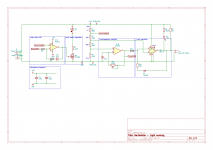Hanalee
Member
- Location
- China, Hongkong
- Occupation
- Electronic Engineer
Hi, all
For this little project, I'm using a LM311P. It is has a collector/emitter output. Because my circuit didn't function the way it should, I started debugging.
With the collector unconnected the emitter (pin 1) still sinks (11 mA) and sources (20 mA) current, when applying a square wave input. I measured mean dc amperage to either rail, so the max is higher. I cannot explain this behavior.
Doing the current measurement on the collector (pin 7) with an unconnected emitter I get 14 mA when sinking, and none when sourcing. But not following the input signal.
Any suggestions what could cause this? Thank you in advance!
For this little project, I'm using a LM311P. It is has a collector/emitter output. Because my circuit didn't function the way it should, I started debugging.
With the collector unconnected the emitter (pin 1) still sinks (11 mA) and sources (20 mA) current, when applying a square wave input. I measured mean dc amperage to either rail, so the max is higher. I cannot explain this behavior.
Doing the current measurement on the collector (pin 7) with an unconnected emitter I get 14 mA when sinking, and none when sourcing. But not following the input signal.
Any suggestions what could cause this? Thank you in advance!



